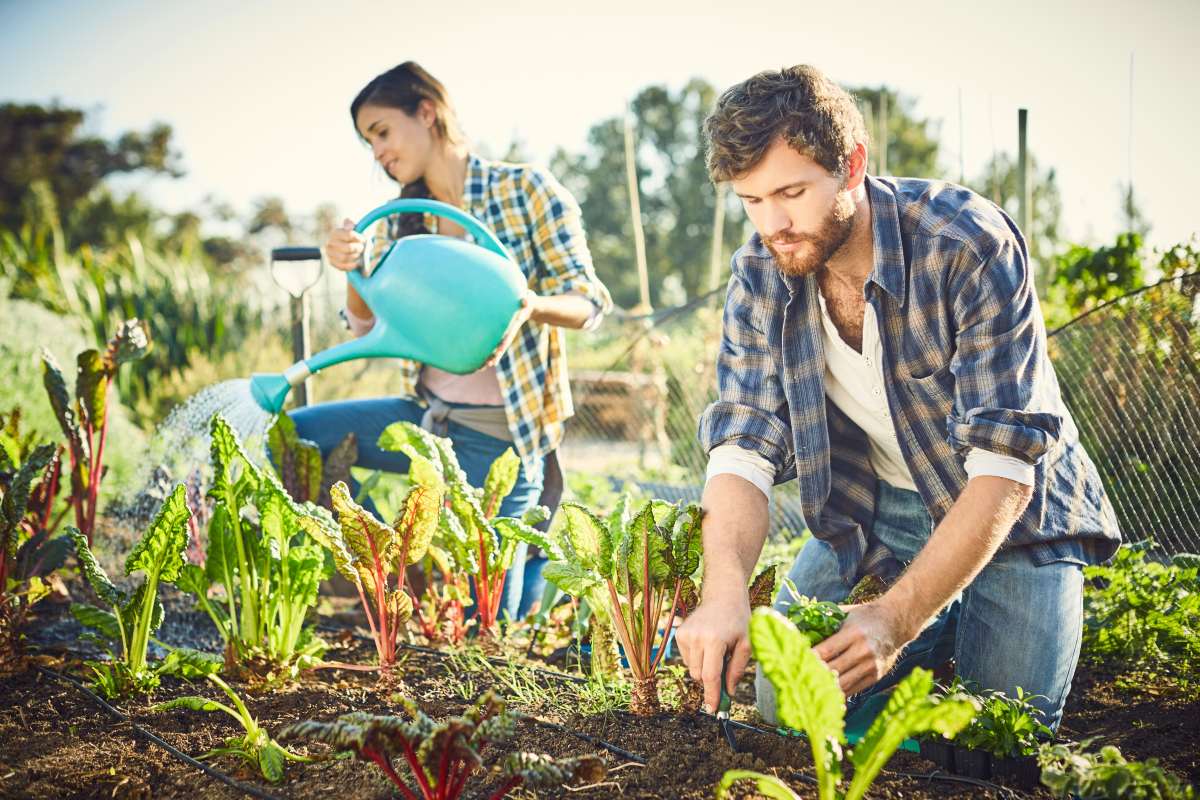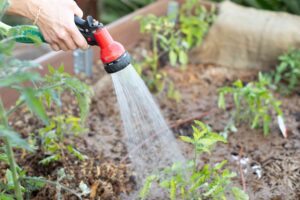How to Water a Vegetable Garden From Seedling to Harvest
In the journey from tiny seed to bountiful harvest, water plays perhaps the most critical role in your vegetable garden’s success. Yet it remains one of the most misunderstood aspects of gardening. Too little water and your plants wither; too much and they can drown or develop disease. The difference between a mediocre harvest and an abundant one often comes down to mastering proper watering techniques.
According to the USDA, improper watering accounts for nearly 40% of vegetable garden failures in home gardens across America. Whether you’re nurturing delicate seedlings or maintaining mature plants heavy with produce, this comprehensive guide will walk you through exactly how to water your vegetable garden at every stage of growth.
Understanding Your Garden’s Water Needs
Before diving into specific watering practices, it’s important to understand the factors that influence how much water your vegetable garden requires. Unlike a lawn that can be set on a simple timer, vegetables have complex and changing water needs based on numerous factors.
Soil Type and Water Retention
Your soil’s composition dramatically affects how you should approach watering. Sandy soils drain quickly and require more frequent watering, while clay soils retain moisture longer but may need deeper, less frequent watering to prevent root rot.
You can test your soil’s water retention by digging a small hole, filling it with water, and observing how quickly it drains. If water disappears within minutes, you likely have sandy soil that will require more frequent irrigation. If it takes hours to drain, you have clay-heavy soil that retains moisture but may become waterlogged.
Loam soil, the ideal garden soil, strikes a balance between drainage and retention. According to the USDA Natural Resources Conservation Service, loam soil consists of approximately 40% sand, 40% silt, and 20% clay. This composition allows roots to access both oxygen and water without becoming waterlogged or dried out.
Climate and Weather Patterns
Your local climate plays a significant role in determining watering needs. Gardeners in hot, arid regions like Arizona will have vastly different watering requirements than those in humid areas like Florida.
Beyond regional climate, daily and weekly weather patterns matter tremendously. A series of cloudy days might reduce water needs by 30%, while a heatwave can increase them by 50% or more. Wind also accelerates evaporation, meaning windy days may require additional watering, particularly for seedlings.
The US Department of Agriculture provides excellent resources on regional growing conditions and water management techniques through their Cooperative Extension Service. You can find location-specific guidance at USDA’s Climate Hubs, which offers targeted information on water management for different regions.
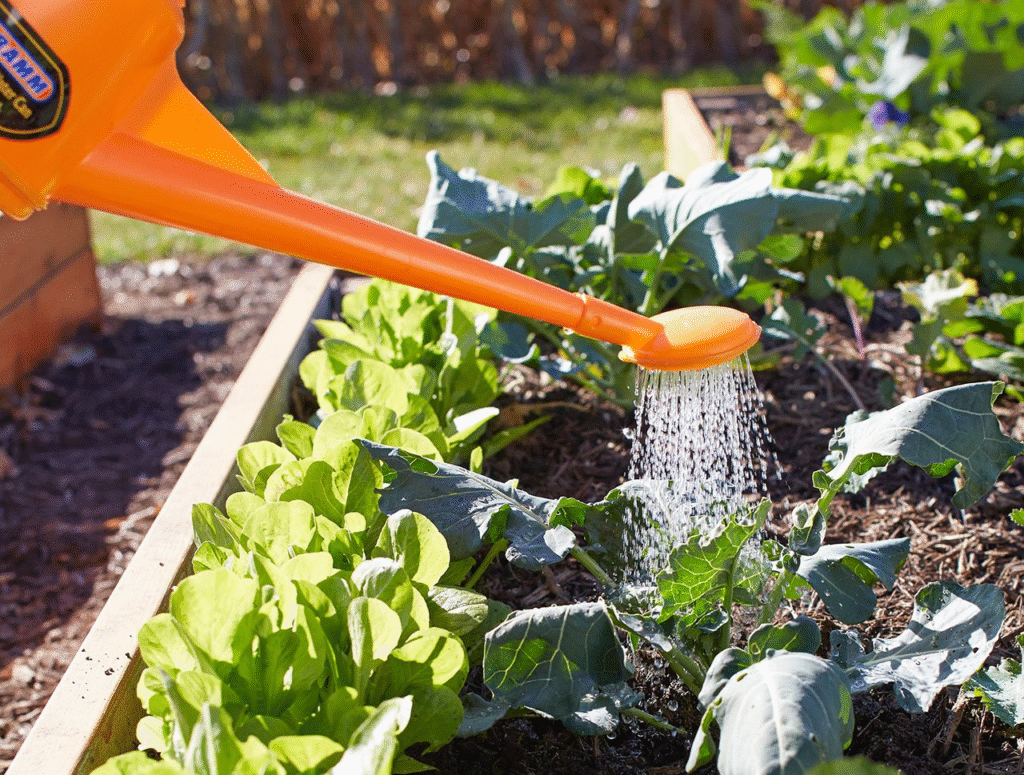
Plant Life Cycle Stages
Each growth stage of your vegetables requires different watering approaches. Here’s an overview of how watering needs change throughout a plant’s life cycle:
- Seed germination – Consistently moist but never soggy soil
- Seedling establishment – Regular, gentle watering to encourage root development
- Vegetative growth – Deeper, less frequent watering to encourage deeper roots
- Flowering & fruit set – Consistent moisture to prevent blossom drop
- Fruit development – Steady watering to support quality fruit production
- Maturation & harvest – Adjusted watering (often reduced) to enhance flavor and prevent splitting
We’ll explore each of these stages in depth throughout this guide.
Watering Tools and Systems
Before discussing specific techniques, let’s review the most effective watering tools for vegetable gardens:
Hand Watering Tools
Hand watering gives you precise control but can be time-consuming for larger gardens. The most common tools include:
Watering cans provide excellent control for seedlings and container gardens. Choose cans with removable rose attachments to adjust water flow.
Hose-end sprayers offer versatility but require careful monitoring to prevent overwatering. Look for models with multiple spray patterns.
Shower wands deliver gentler water pressure and are ideal for not disturbing delicate seedlings or washing away soil.
Automated Irrigation Systems
For larger gardens or busy gardeners, automated systems provide consistency:
Drip irrigation delivers water directly to the soil near plant roots, minimizing evaporation and keeping foliage dry, which reduces disease. Research from the EPA indicates drip systems can reduce water usage by 30-50% compared to overhead sprinklers.
Soaker hoses function similarly to drip systems but with less precision. They work well for row crops and dense plantings.
Timer systems can be attached to any irrigation method to automate watering schedules. Smart timers can even adjust based on weather conditions.
Watering Seedlings: The Crucial First Stage
The seedling stage is perhaps the most vulnerable period in a plant’s life cycle. Proper watering during this time sets the foundation for robust growth later on.
Pre-Germination Moisture
Before your seeds even sprout, proper soil moisture is critical. Seeds need consistent moisture to trigger germination, but too much water can cause them to rot.
For outdoor direct-seeded crops, prepare the bed by thoroughly watering it the day before planting. This ensures the soil is moist throughout rather than just at the surface. After planting, use a gentle mist or shower setting on your hose to water the seed area.
For indoor seed starting, pre-moisten your seed starting mix before filling trays. The mix should feel like a wrung-out sponge—damp but not dripping. Cover seed trays with clear lids or plastic wrap to maintain humidity until germination occurs.
Early Seedling Care
Once seedlings emerge, consistent moisture becomes even more critical. Young seedlings have limited root systems that can’t reach far for water. According to research from the University of California Cooperative Extension, seedlings typically need water when the top 1/4 inch of soil feels dry to the touch.
For indoor seedlings, bottom watering is often the best approach. Place your seed trays in a shallow container of water and allow the soil to draw moisture up from below. This prevents disturbing delicate seedlings and reduces the risk of damping-off disease, a common fungal problem that kills seedlings.
For outdoor seedlings, use a fine spray or mister attachment on your watering can or hose. Water early in the morning to give leaves time to dry before evening, reducing disease risk.
Transitioning to Outdoor Growing
When moving seedlings from indoors to your garden (transplanting), watering becomes even more critical. Harden off your seedlings by gradually introducing them to outdoor conditions over 7-10 days.
Immediately before transplanting, water both your seedlings and the garden bed thoroughly. After transplanting, create a small basin around each plant and fill it with water, allowing it to soak in directly at the root zone. Water transplants daily for the first week, then gradually reduce frequency as they establish.
Deep Watering for Established Plants
Once your vegetable plants have established themselves with stronger root systems, it’s time to shift your watering strategy to encourage healthy, deep root development.
The Deep Watering Method
Deep watering involves applying water less frequently but in greater amounts, encouraging roots to grow downward in search of moisture. This creates more resilient plants that can better withstand dry periods.
For most established vegetable plants, water deeply enough to moisten the soil to a depth of 6-8 inches. You can check this by digging a small hole after watering to see how far the moisture has penetrated.
The U.S. Environmental Protection Agency recommends applying about 1 inch of water per week to most vegetable gardens, though this varies based on climate, soil type, and specific plant needs. One inch of water typically penetrates 6-8 inches into most garden soils.
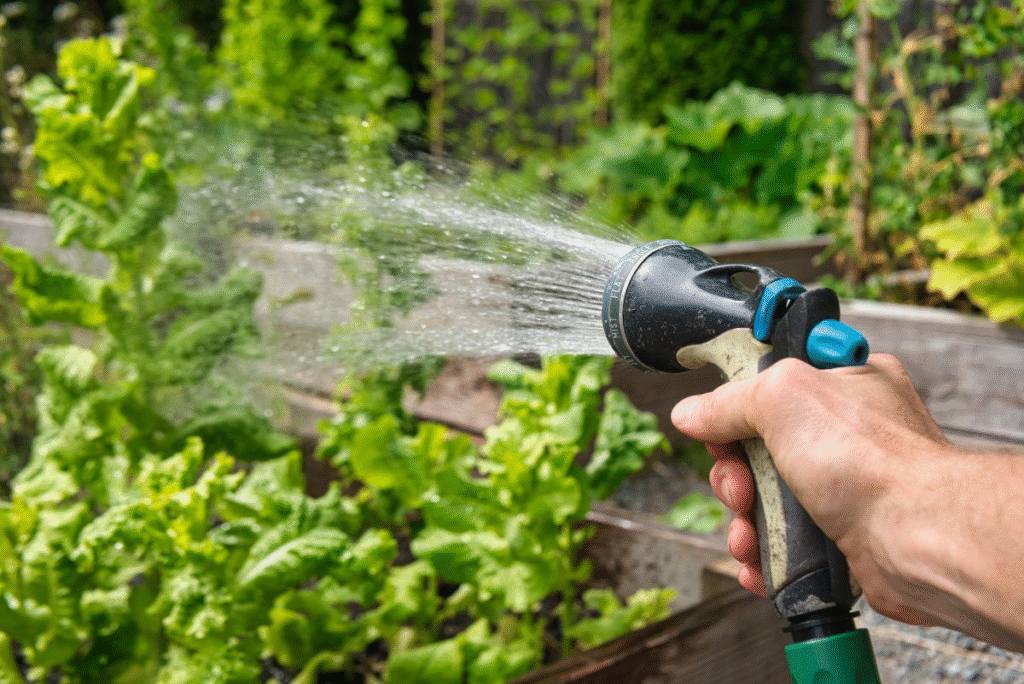
Watering Frequency vs. Duration
Many gardeners make the mistake of watering a little bit every day, which promotes shallow root systems. Instead, water thoroughly but less frequently. In typical conditions, most established vegetable gardens benefit from watering 2-3 times per week rather than daily.
The table below provides general guidelines for watering frequency based on soil type and weather conditions:
| Soil Type | Normal Weather | Hot & Dry Weather | Cool & Cloudy Weather |
|---|---|---|---|
| Sandy | Every 2-3 days | Daily | Every 4-5 days |
| Loam | Every 3-4 days | Every 2 days | Weekly |
| Clay | Weekly | Every 3-4 days | Every 8-10 days |
Remember that these are starting points that should be adjusted based on your specific conditions and plant observations.
Signs of Improper Watering
Learning to recognize signs of water stress will help you fine-tune your watering schedule:
Underwatering signs include wilting (especially in the afternoon), curling leaves, slowed growth, and dry soil several inches deep. Many plants, particularly leafy greens and cucumbers, will show visible wilting before permanent damage occurs.
Overwatering signs are sometimes less obvious but include yellowing leaves, soft stems, fungal growth on soil, and consistently wet soil. Root vegetables like carrots and radishes are particularly susceptible to rotting in waterlogged conditions.
The National Gardening Association recommends the “finger test” as the simplest way to determine if watering is needed: stick your finger about 2 inches into the soil near your plants. If it feels dry at that depth, it’s time to water.
Critical Watering Periods for Common Vegetables
Different vegetables have specific growth stages when proper watering is especially crucial for successful harvests. Understanding these critical periods will help you prioritize your watering efforts.
Fruiting Vegetables
Tomatoes, peppers, eggplants, and other fruiting vegetables require consistent moisture during flowering and fruit development. Inconsistent watering during these periods can cause blossom end rot, cracking, and poor fruit set.
For tomatoes, the critical watering period begins when flowers appear and continues through fruit development. According to research from the University of Maryland Extension, maintaining even soil moisture can reduce blossom end rot by up to 90%.
Pepper plants are particularly sensitive during the transition from flowering to fruit set. Water stress during this period can cause flowers to drop without forming peppers. Once peppers begin developing, they benefit from slightly reduced watering to enhance flavor concentration.
Root Vegetables
Carrots, radishes, beets, and other root crops require consistent moisture during their early growth stages to ensure proper root formation. Once established, they need moderate moisture levels—too much water can cause roots to crack or develop fungal diseases.
For carrots, the first three weeks after germination are especially critical, as dry conditions can result in stunted, woody roots. Once the tops are established, reduce watering slightly to encourage the roots to grow deeper in search of moisture.
Leafy Greens
Lettuce, spinach, kale, and other leafy vegetables have shallow root systems and require more frequent watering than deeper-rooted crops. Consistent moisture is essential throughout their growth cycle, as even brief dry periods can cause bitterness and bolting (premature flowering).
The National Center for Appropriate Technology (NCAT) recommends monitoring leafy greens closely and watering whenever the top inch of soil begins to dry out. For more information on specific watering needs for different vegetable crops, visit the USDA Agricultural Research Service’s Crop Production guides.
Seasonal Watering Adjustments
As the growing season progresses, your watering strategy should evolve to match changing conditions and plant needs.
Spring Watering Strategies
Spring brings variable conditions that require adaptable watering approaches. Cool, wet periods may require minimal supplemental watering, while warm, dry spells demand more attention.
Focus on establishing strong root systems in spring by watering thoroughly but allowing soil to dry slightly between waterings. This encourages roots to grow deeper in search of moisture, creating more drought-resistant plants for summer.
For spring crops like peas, lettuce, and radishes, pay particular attention to consistent moisture during germination and early growth. These cool-season crops often have shallow roots that dry out quickly in spring winds.
Summer Watering Challenges
Summer heat presents the greatest watering challenges for most gardeners. Evaporation rates increase dramatically, and plants use more water for cooling and transpiration.
During hot periods, water early in the morning (ideally between 5:00-9:00 AM) when temperatures are lower and winds are calmer. This minimizes evaporation and allows foliage to dry before evening, reducing disease risk.
Consider applying organic mulch 2-3 inches deep around established plants to conserve moisture and moderate soil temperature. Research from the University of California shows that mulching can reduce water needs by 25-50% and keep root zones up to 10°F cooler during heat waves.
If your region experiences water restrictions during summer, prioritize watering based on crop value and sensitivity. Establish a “triage” system that maintains moisture for high-value crops like tomatoes while allowing more drought-tolerant plants like mature herbs to receive less water.
Fall Watering Considerations
As temperatures cool in fall, reduce watering frequency but maintain adequate moisture for fall crops. Many fall vegetables, including Brussels sprouts, carrots, and kale, develop better flavor with slightly reduced watering as they mature.
For crops that will be harvested in fall, begin tapering watering about two weeks before harvest. This concentration of plant sugars and flavors often results in sweeter, more flavorful produce.
Water Conservation Techniques
With increasing water scarcity concerns across many regions, implementing water conservation techniques is both environmentally responsible and economically sensible.
Mulching Methods
Mulching is perhaps the single most effective water conservation technique for vegetable gardens. Organic mulches like straw, leaf compost, or grass clippings provide multiple benefits:
- Reduce evaporation from soil surface by up to 70%
- Moderate soil temperature fluctuations
- Suppress weeds that compete for moisture
- Add organic matter to soil as they decompose
Apply organic mulch in a 2-3 inch layer around established plants, keeping it slightly away from stems to prevent rot. Refresh mulch as it decomposes throughout the season.
Capturing and Reusing Water
Rainwater harvesting allows you to collect free, chemical-free water for your garden. A simple rain barrel can capture thousands of gallons over a growing season. According to the EPA, a 1,000 square foot roof can collect approximately 600 gallons of water from just 1 inch of rainfall.
You can also reuse household water from sources like cooking pasta or vegetables (once cooled), fish tank cleaning, or dehumidifiers. These sources often contain trace nutrients that benefit garden plants.
The USDA offers excellent resources on rainwater harvesting through their Natural Resources Conservation Service at USDA NRCS Rainwater Harvesting, including specifications for building rain gardens and installing collection systems.
Efficient Irrigation Planning
Grouping plants with similar water needs together (hydrozoning) allows you to water more efficiently. For example, plant thirsty crops like celery and cucumber together, separate from drought-tolerant crops like rosemary and sage.
Consider your garden’s natural microclimates when planning irrigation. Areas that receive afternoon shade may require less frequent watering than those in full sun. Similarly, low spots that collect water naturally may need different irrigation than raised areas.
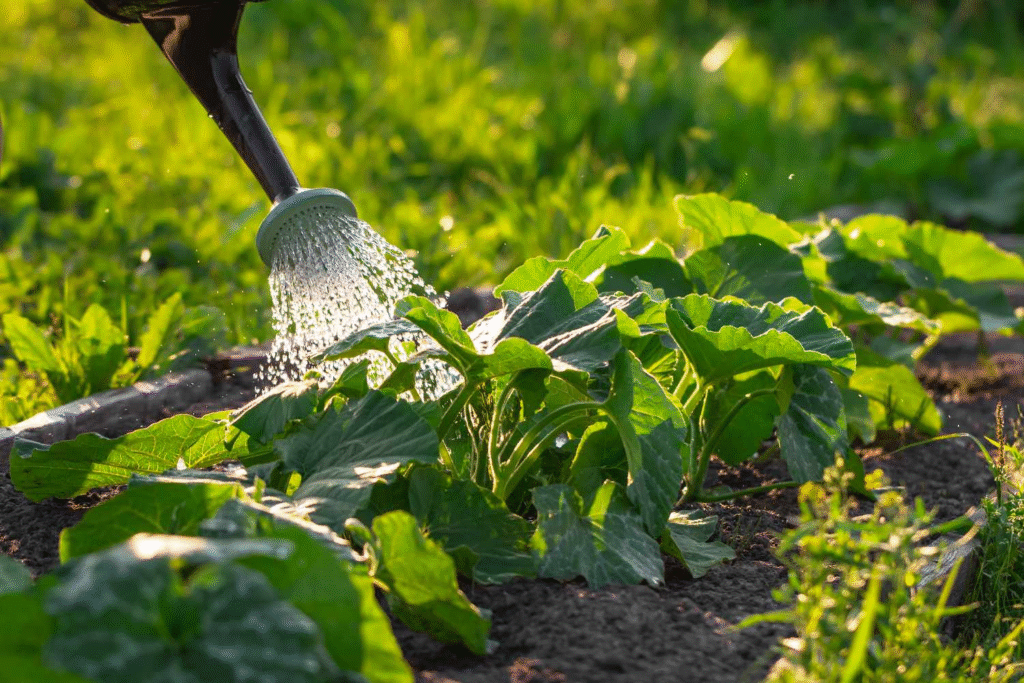
Troubleshooting Common Watering Problems
Even experienced gardeners encounter watering challenges. Here’s how to address some common issues:
Dealing with Drought
During extended dry periods, prioritize watering based on plant vulnerability and value. Seedlings and recently transplanted vegetables need the most protection, followed by flowering and fruiting plants. Established perennial herbs and mature plants can often withstand some drought stress.
Create temporary shade for vulnerable plants using row covers or shade cloth during the hottest parts of the day. This can reduce water loss through transpiration by up to 30%.
If severe drought requires rationing water, consider saving some vegetables while letting others go. Concentrate your limited water on high-value crops that are approaching harvest rather than trying to save everything with inadequate water.
Managing Excess Rainfall
Too much rain can be as problematic as too little. Excessive moisture can lead to root rot, nutrient leaching, and increased disease pressure.
If your garden receives heavy rainfall, avoid walking on wet soil, which causes compaction and further reduces drainage. Consider creating temporary drainage channels to direct water away from sensitive crops.
For raised beds that have become waterlogged, gently fork the soil between plants to introduce air and speed drying. Adding additional compost or organic matter in the fall can improve drainage for future seasons.
Conclusion
Mastering the art of watering your vegetable garden requires understanding the changing needs of your plants throughout their life cycles, from delicate seedlings to mature plants ready for harvest. By implementing the strategies outlined in this guide—proper watering depth, appropriate timing, efficient irrigation methods, and conservation techniques—you’ll be well on your way to healthier plants and more abundant harvests.
Remember that successful watering is less about following rigid rules and more about developing an observant eye and responsive approach. Your garden will tell you what it needs if you pay attention to the signs your plants provide.
With each growing season, you’ll gain valuable experience specific to your garden’s unique conditions. This knowledge, combined with the fundamental principles covered here, will help you develop an intuitive understanding of your garden’s water needs that no manual alone can provide.
